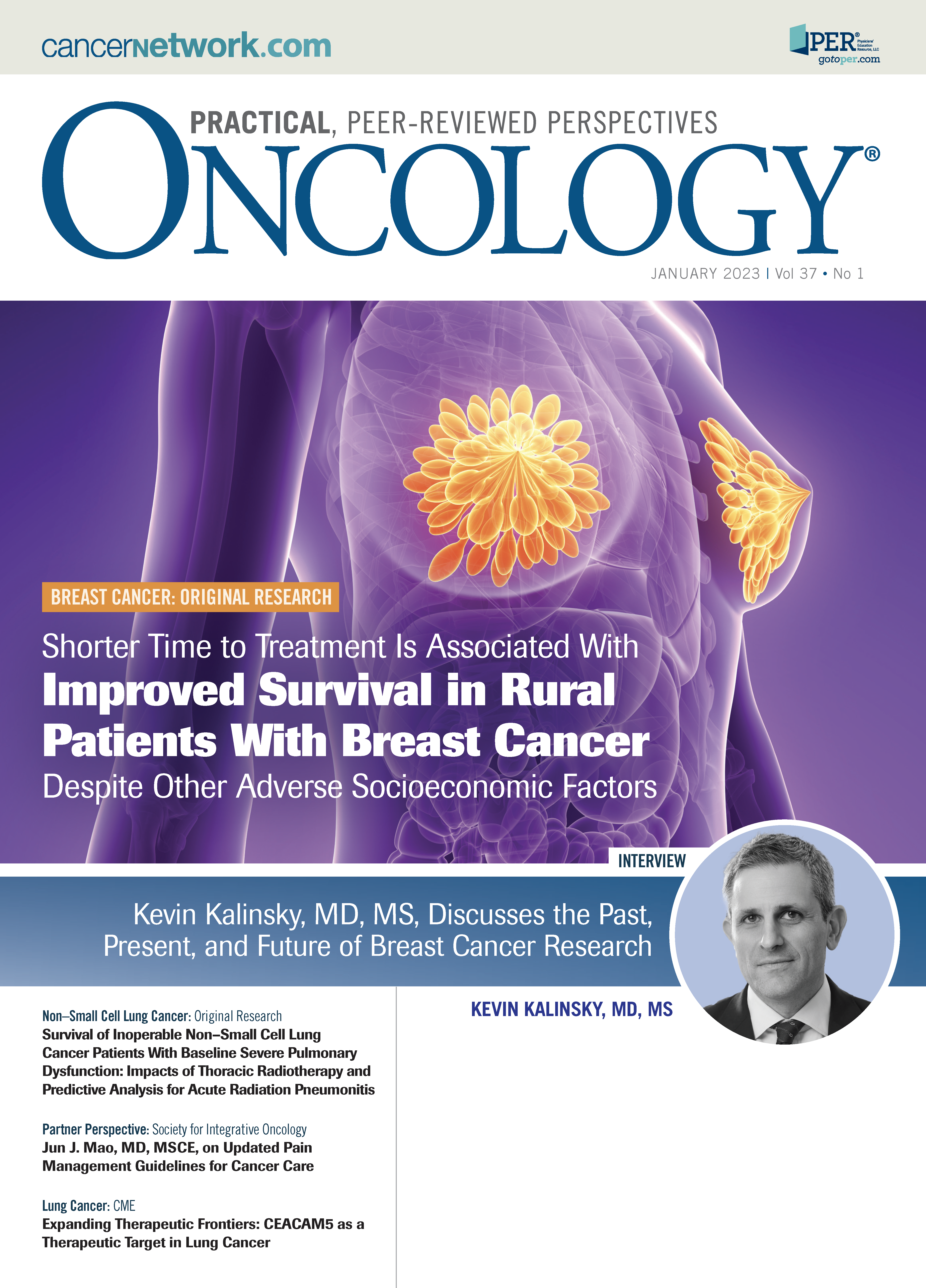Survival of Patients With Inoperable Non–Small Cell Lung Cancer With Baseline Severe Pulmonary Dysfunction: Impacts of Thoracic Radiotherapy and Predictive Analysis for Acute Radiation Pneumonitis
Qianyue Deng, MD, and colleagues examine the efficacy of thoracic radiotherapy for the treatment of unresectable non-small cell lung cancer.
ABSTRACT
BACKGROUND AND PURPOSE. Currently, there is no standard treatment for patients with lung cancer with deteriorated pulmonary function. In this study, we aimed to assess the efficacy of thoracic radiotherapy for unresectable non–small cell lung cancer (NSCLC) with baseline severe pulmonary dysfunction and severe acute radiation pneumonitis (SARP).
METHODS. Patients were categorized into a radiotherapy group and a nonradiotherapy group, followed by analysis of clinical variables. A Cox regression was used to evaluate the impact of various factors on overall survival (OS). Each SARP factor’s predictive value was assessed using logistic regression, receiver operating characteristic curve, and Kaplan-Meier analyses.
RESULTS. The median OS in the radiotherapy group was 21.6 months vs 8.9 months in the nonradiotherapy group. Cox analysis revealed that chemotherapy (HR, 0.221; 95% CI, 0.149-0.329; P < .001) and radiotherapy (HR, 0.589; 95% CI, 0.399-0.869; P = .008) are independent prognostic factors for the current cohort. The data suggested that the ipsilateral lung V10 (ilV10, the percentage of the lung volume that received more than 10 Gy) was an independent predictor of SARP.
CONCLUSIONS. Our findings suggested that thoracic radiotherapy might be associated with clinical benefits to inoperable NSCLC in patients with severe pulmonary dysfunction and that ilV10 may be involved in the prediction of risk for SARP in these patients.
KEYWORDS. Severe pulmonary dysfunction; non–small cell lung cancer; thoracic radiotherapy; predictive factors; severe acute radiation pneumonitis
Oncology (Williston Park). 2023;37(1):26-33.
DOI: 10.46883/2023.25920983
Introduction
Smokers with chronic obstructive pulmonary disease (COPD) have a 2 to 5 times higher lung cancer risk than non-COPD smokers.1-4 According to international guidelines, a ratio of forced expiratory volume in 1 second (FEV1) to forced vital capacity (FVC) of less than 0.70 after inhaling bronchodilators is a diagnostic criterion for COPD.5 Patients with COPD or pulmonary interstitial diseases and lung cancer also have pretreatment pulmonary dysfunction. Currently, no standard treatment is available for those patients with baseline severe pulmonary dysfunction who might not tolerate surgery or definitive concurrent chemoradiotherapy (CCRT). Those patients who have impaired pulmonary function were often subjected to stereotactic radiotherapy treatment in early-stage cases, whereas advanced-stage cases could only receive medical treatment without thoracic radiotherapy.6-10
As part of either definitive or palliative therapy, radiotherapy may help treat all stages of NSCLC and small cell lung cancer.11,12 The role of conventional-fractionated thoracic radiotherapy in patients with NSCLC and serious pulmonary dysfunction was unclear due to the consideration of severe acute radiation pneumonitis (SARP). According to the results of our previouslyreported study, the mean lung dose (MLD) and carbon monoxide diffusing capacity of the lungs (DLCO%) possess the potential to predict the SARP risk in patients with NSCLC and baseline moderate pulmonary dysfunction.13 To date, no research has evaluated the effectiveness and radiotoxicity of thoracic radiotherapy in patients with NSCLC and severe pulmonary dysfunction at the outset. In the study reported below, we gathered information on clinical causes, treatment, survival status, dosimetric parameters, and SARP frequency in these patients to assess the clinical benefits of thoracic radiotherapy and to identify possible risk factors for SARP.
Patients and Methods
Patients
A total of 33,582 patients who had been diagnosed with NSCLC pathologically in West China Hospital and Sichuan Provincial People’s Hospital between January 2014 and December 2018 were retrospectively reviewed. Among these, the records of 795 demonstrated evidence of pretreatment severe pulmonary dysfunction. Severe pulmonary dysfunction was defined according to the American Thoracic Society and the European Respiratory Society; the actual or estimated ratio of FEV1 ranged from 35% to 49%.14,15 The current study has not included patients with extremely severe pulmonary dysfunction (FEV1 <35%) because they were often unable to receive most tumor-related therapy due to poor pulmonary function. The predetermined inclusion criteria were NSCLC with a definite pathological diagnosis, pretreatment severe pulmonary dysfunction, and an ECOG performance status of 0 to 2. Patients who had undergone surgery, targeted therapy, or stereotactic radiation were excluded from the study. Ultimately, 170 patients were eligible for the study and were divided into 2 groups: a radiotherapy group (53 patients) and a nonradiotherapy group (117 patients).
Introduction to Clinical and Dose-Volume Histogram Factors
Clinical factors including age, ECOG performance status, gender, pathological diagnosis, laterality, sites of the tumor, smoking status, tumor-node-metastasis stage, pulmonary function, radiotherapy procedures, chemotherapytreatments, and survival were recorded. Restaging of all patients was conducted according to the staging scheme of the 8th edition of the Union for International Cancer Control/American Joint Committee on Cancer to improve data comparability.16 To obtain the lung volume, the gross tumor volume (GTV) was subtracted from the total lung volume (TLV).17,18 The proportion of lung/heart volume that received greater than variable x Gy was known as Vx. From the dose-volume histogram (DVH), we extracted and collected the following parameters: total/ipsilateral/contralateral lung V5/10/20/30, heart V10/20/30/40/50, mean dose (MD), planning target volume (PTV) radiation dose, and TLV. The convolution/superposition algorithm was used to measure all of these parameters from the planned dose distribution. The conversion of DVH parameters was done for patients who had not completed their radiotherapy treatment schedule.
Radiotherapy
Of the 53 patients who received thoracic radiotherapy, 3 received radiotherapy alone, 21 received concomitant chemoradiotherapy, and 29 received sequential chemoradiotherapy. Intensity modulated radiation therapy (IMRT) with a cumulative dose of 36 Gy-66 Gy, at 1.8 Gy-3 Gy per fraction, was administered 5 days a week. Targets were defined based on reports 62 and 83 of the International Commission on Radiation Units and Measurements.19-21 GTV was identified as a tumor that could be seen macroscopically on CT images, including lymph nodes with a diameter of greater than 1 cm. To account for setup instability and respiratory motion, the GTV plus a 5- and 10-mm margin around the affected lymph nodes and lung tissue, respectively, comprised the PTV. For normal tissues, the following dose-volume constraints were established:
- to the whole lung, V20 ≤30%-35% and MLD ≤15 Gy;
- to the heart, V50 ≤25% and MD ≤20 Gy;
- to the spinal cord, ≤50 Gy; and
- to the esophagus, MD ≤34 Gy.
Chemotherapy
Chemotherapy was given to 114 patients, with 50 receiving concurrent or sequential radiotherapy. Chemotherapy was given every 21 days with a median of 7 cycles (range, 2-12). First-line chemotherapy included docetaxel, paclitaxel, pemetrexed, and etoposide combined with carboplatin or cisplatin. Combination treatment with bevacizumab had a significant effect on patients with nonsquamous cell lung cancer. Pemetrexed and docetaxel were given as second-line therapy for patients with nonsquamous and squamous cell lung cancer. None of the studied population had received immune checkpoint inhibitors. The National Comprehensive Cancer Network (NCCN) protocols were used to determine all doses and changes to the chemotherapy regimen.11
TABLE 1. Baseline Characteristics of All Patients (N = 170)
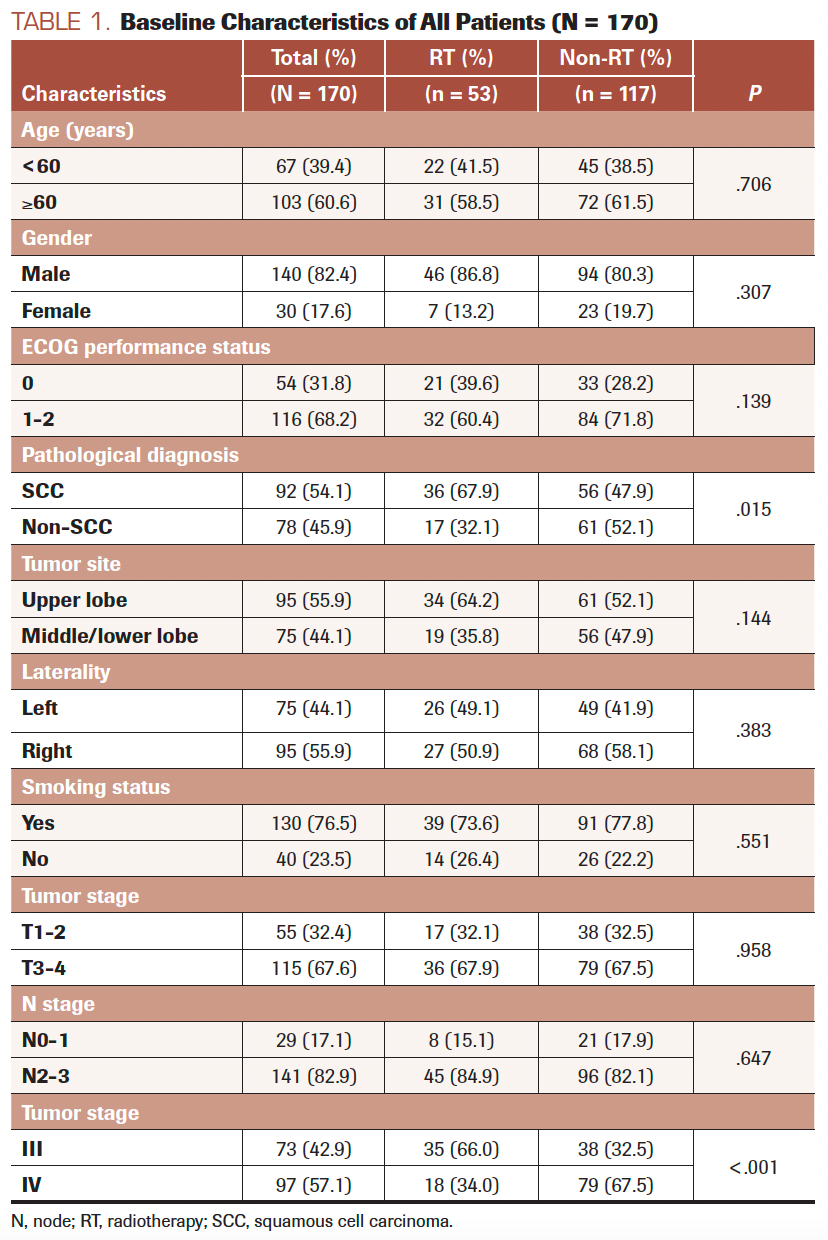
End Point Definitions
Determination of overall survival (OS) was assessed by using the date of pathologic diagnosis of lung cancer to the date of all-cause death or the last date of follow-up for all patients in the survival study. In the case of radiation pneumonitis (RP), the primary end point was the occurrence of SARP at grade 3 or above with 3 months of radiotherapy. According to the Common Terminology Criteria for Adverse Events (version 5.0), grade 3 RP was classified as an asymptomatic disease affecting daily events and requiring oxygen inhalation or hospital support.22 Based on clinical signs, changes in CT pictures and proof of oxygen inhalation, and corticosteroid administration in medical records, a minimum of 2 experienced radiation oncologists jointly supported the diagnosis of SARP.
Statistical Analysis
Chi-squared tests were employed to evaluate the relative balance of baseline characteristics between the radiotherapy and nonradiotherapy groups. The Kaplan-Meier test and log-rank test were conducted to calculate OS and to determine the significance of the differences between the 2 groups. The effect of various factors on OS was studied using univariable and multivariable Cox proportional hazards models. First, with the univariate Cox regression, we assessed the predictive value of individual factors for OS. Second, in multi-variate analysis, factors with P < .05 by univariate analyses were included.
In 53 patients who received radiotherapy, a univariate logistic regression model was utilized to assess the ability of every single factor to predict SARP. In the multivariate logistic regression model, only univariate variables with P < .05 were included. The optimal cutoff value of the predictor was determined using receiver operating characteristic (ROC) curve analysis. The Kaplan-Meier test was performed to obtain the hazard ratio for SARP and incidence curves. All tests were 2-sided and a P value of less than .05 was considered statistically significant. IBM SPSS statistics software version 27.0 was used to analyze the data.
Results
Patient Characteristics
Table 1 summarizes baseline features of the sample population. The majority of patients were men who had previously smoked. Of 170 patients, 114 (67.1%) received chemotherapy and 53 (31.2%) received radiotherapy. There was a significant variation in tumor stage between the radiotherapy and nonradiotherapy groups (P < .001). The mean radiation dose in the radiotherapy group was 54.5 Gy (range, 36-66 Gy).
Survival Outcomes
In this study, 138 deaths were recorded with a median follow-up time of 38.0 months (95% CI, 36.1-39.9). The median OS was found to be 12.9 months (95% CI, 10.6-15.2). Of the 170 analyzed patients, 32 were still alive at the final analysis, 14 (26.4%) in the radiotherapy group and 18 (15.4%) in the nonradiotherapy group, respectively. In the radiotherapy group, the median OS was 21.6 months (95% CI, 19.5- 23.7) while in the nonradiotherapy group, it was 8.9 months (95% CI, 6.5- 11.4; HR, 0.481; 95% CI, 0.344-0.673; P < .001; Figure 1).
We evaluated the OS in radiotherapy and nonradiotherapy groups who were stratified by age, gender, performance status, pathology, smoking status, and tumor stage (Figure 2). Our study found that radiotherapy could improve OS in all subgroups except females (HR, 0.650; 95% CI, 0.292-1.447; P = .319), patients with performance status of 0 (HR, 0.557; 95% CI, 0.297-1.044; P = .067), and nonsmokers (HR, 0.556; 95% CI, 0.278-1.112; P = .104).
FIGURE 1. Overall Survival of Patients in the Present Study, by Treatment
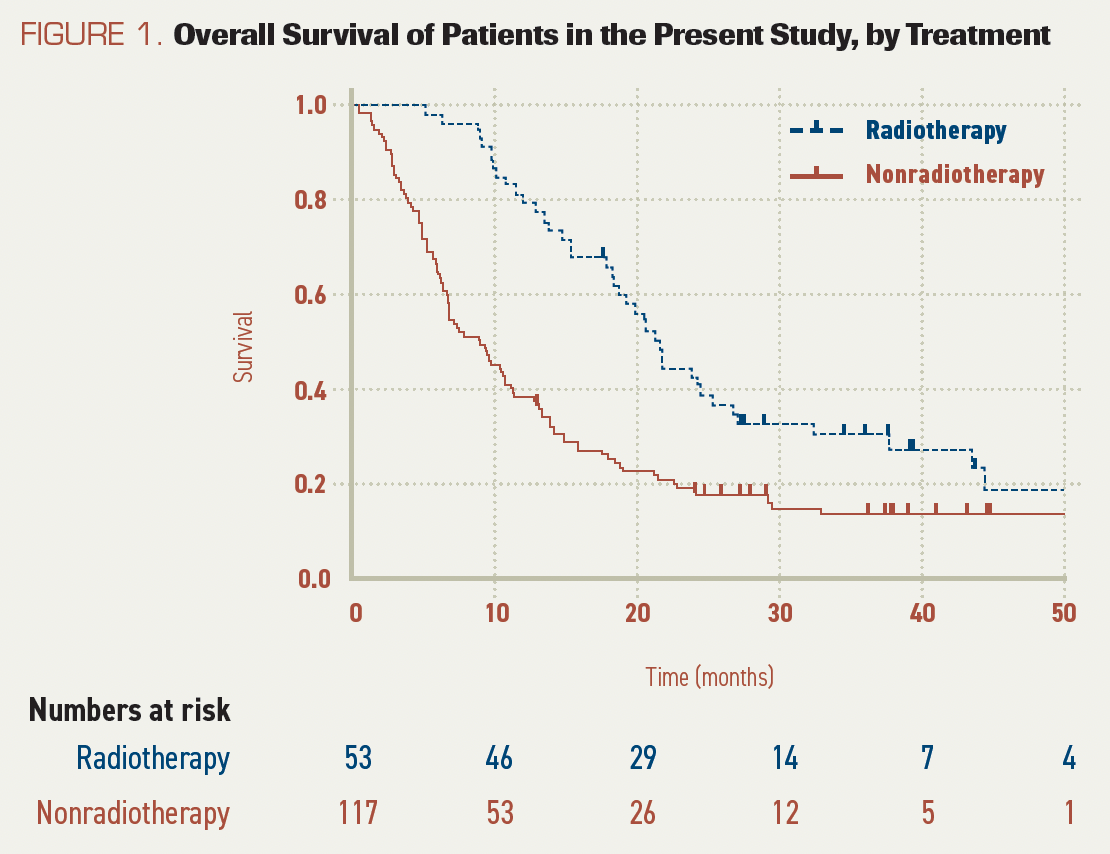
FIGURE 2. Overall Survival in Subgroups Between Radiotherapy and Nonradiotherapy Groups
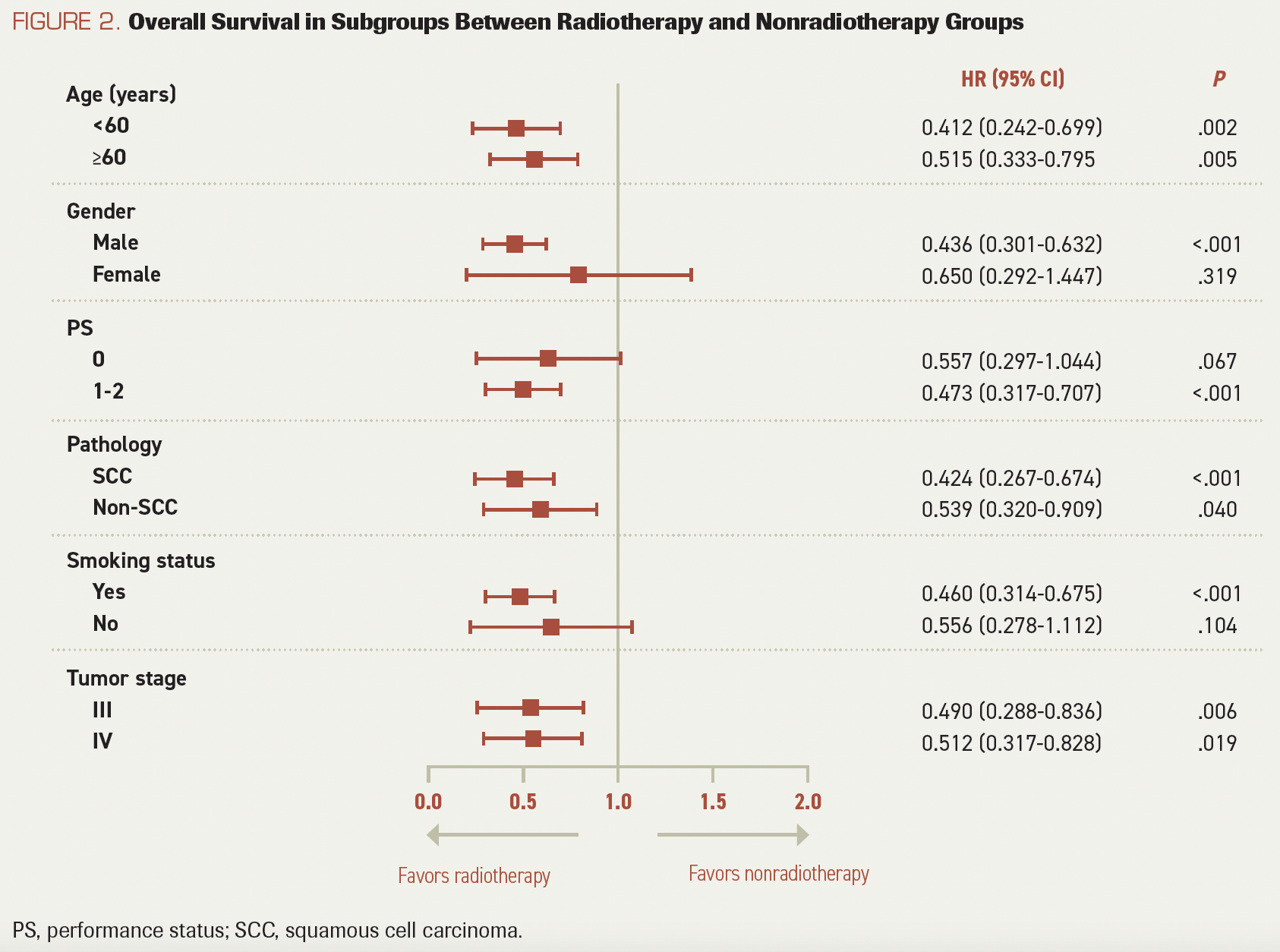
Univariate and Multivariate Analyses for OS
In univariate analysis, tumor stage, chemotherapy, and radiation were found to be statistically associated with OS (Table 2). Chemotherapy (HR, 0.221; 95% CI, 0.149-0.329; P < .001) and radiotherapy (HR, 0.589; 95% CI, 0.399-0.869; P = .008) were found to be independent prognostic factors for OS in the current cohort by multivariate analysis.
TABLE 2. Cox Regression Analysis for Overall Survival
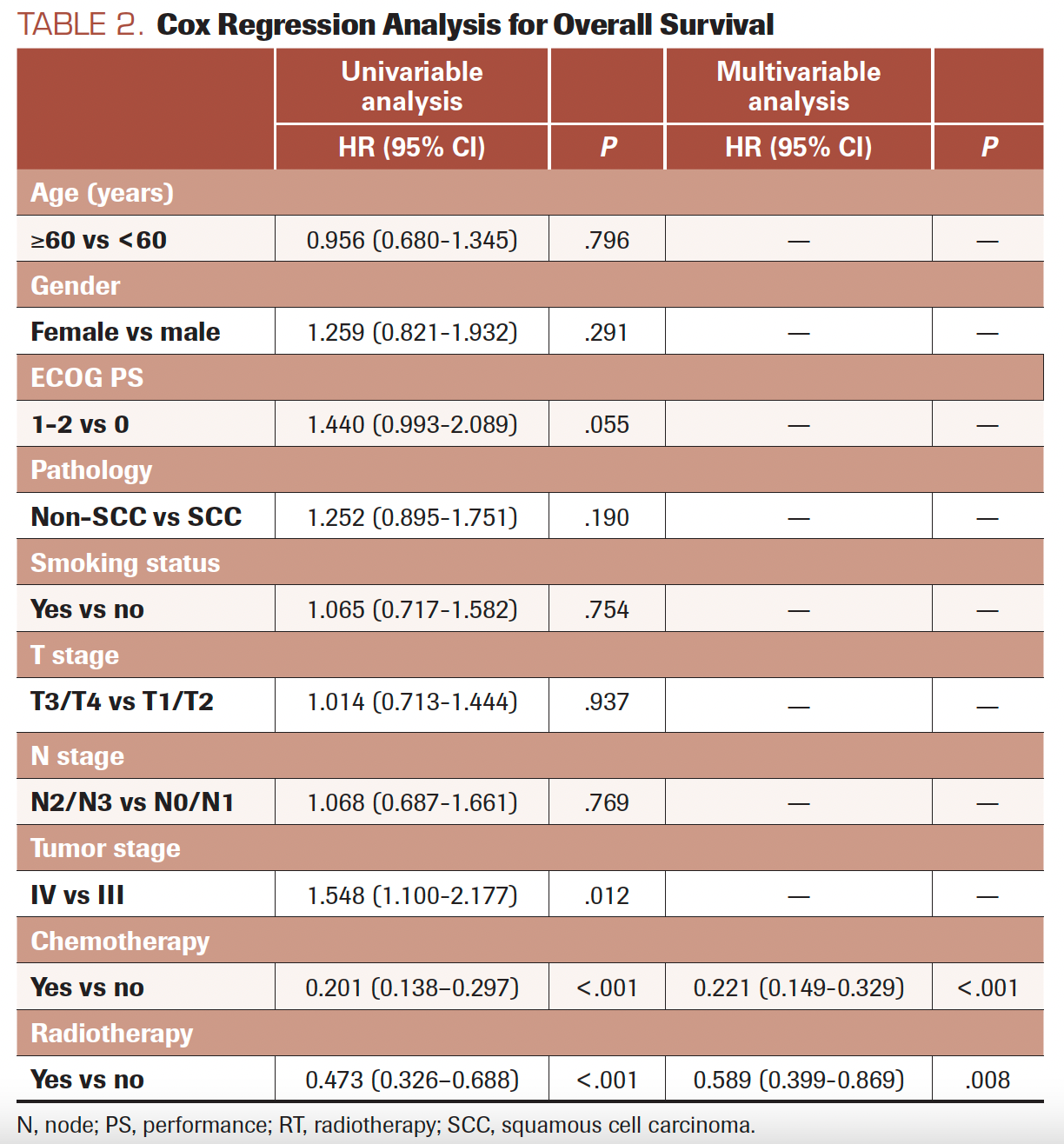
Incidence of Toxicity
Among 53 patients who had received radiotherapy, radiation esophagitis was diagnosed in 4 patients (7.5%), 2 (3.8%) developed grade 2 or grade 3 radiation esophagitis, and 16 (30.2%) were diagnosed with SARP (grade 3, 15 patients [28.3%]; grade 4, 1 patient [1.9%]). The median time between the end of radiotherapy and the onset of SARP was 42 days (range, 16-85).
Univariate and Multivariate Analyses for Predicting SARP
In univariate analysis, total lung V10, total lung V20, total lung V30, total lung mean dose, ipsilateral lung (il) V5, ilV10, ilV20, ilV30, ipsilateral lung mean dose, heart V10, heart mean dose, TLV, age, and tumor stage were statistically associated with SARP, as seen in Table 3. These factors were all involved in the multivariate analysis. Only ilV10 (odds ratio 1.093; 95% CI, 1.030-1.161; P = .004) was found to be an independent predictor of SARP by multivariate analysis.
ROC Curve and Cox Regression Analyses for SARP
According to the ROC curve, the area under the curve of ilV10 was 0.785 (95% CI, 0.661-0.909; P = .001), with an optimal threshold above 50.7% (Figure 3a). The patients were then grouped according to the mean ilV10. Compared with the ilV10-low group (ilV10 ≤ mean), the ilV10-high group (ilV10 > mean) possessed higher SARP risk (HR, 5.33; 95% CI, 1.99-14.29; P = .003; Figure 3b).
TABLE 3. Logistic Regression Analysis of the DVH Parameters and Clinical Factors in Predicting SARP (n = 53)
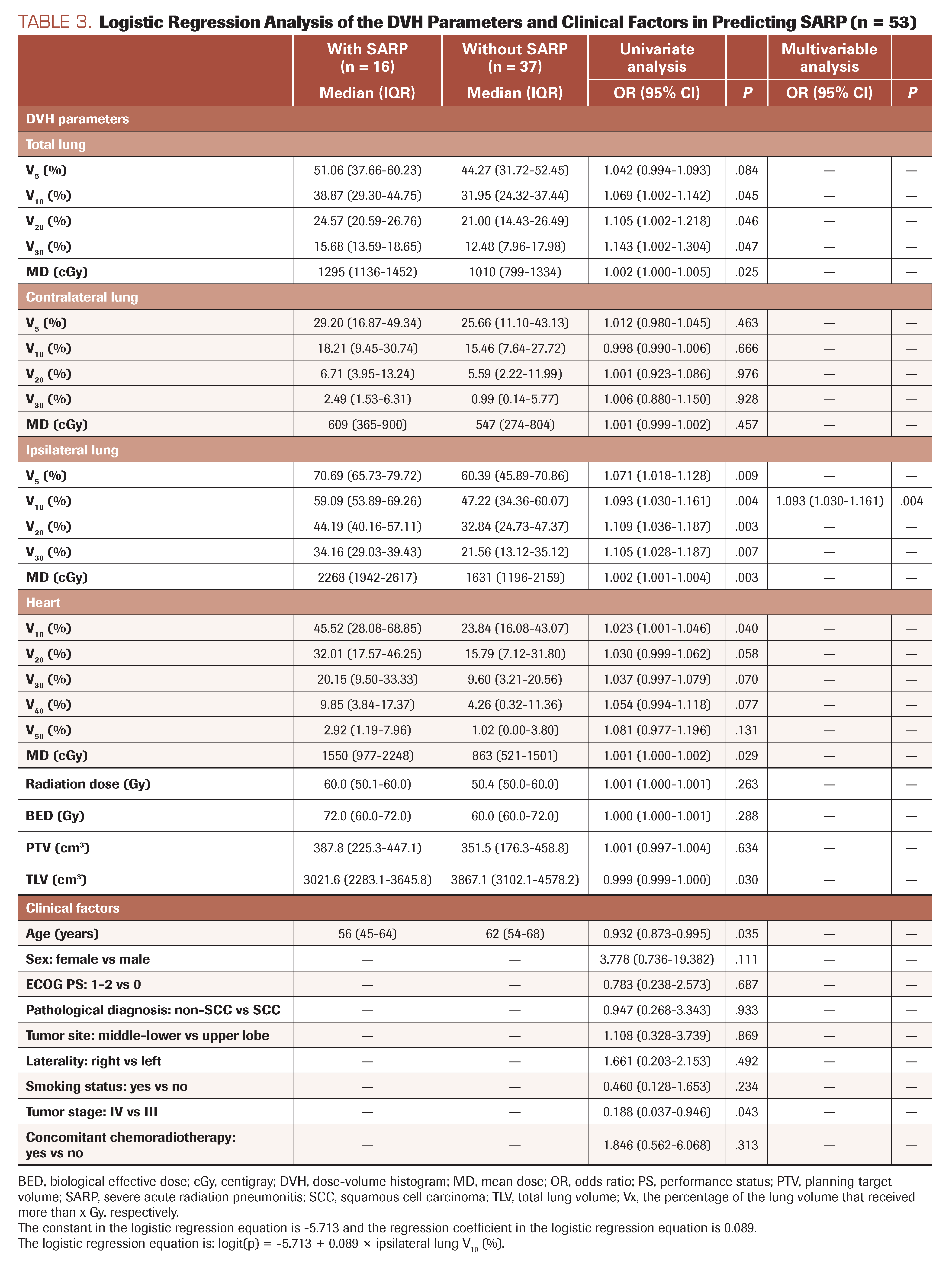
FIGURE 3. (A) ROC Curve of iIV10 for SARP in Present Study; (B) Kaplan-Meier Estimates for the Total Hazards for SARP (iIV10-low vs iIV10-high Group)
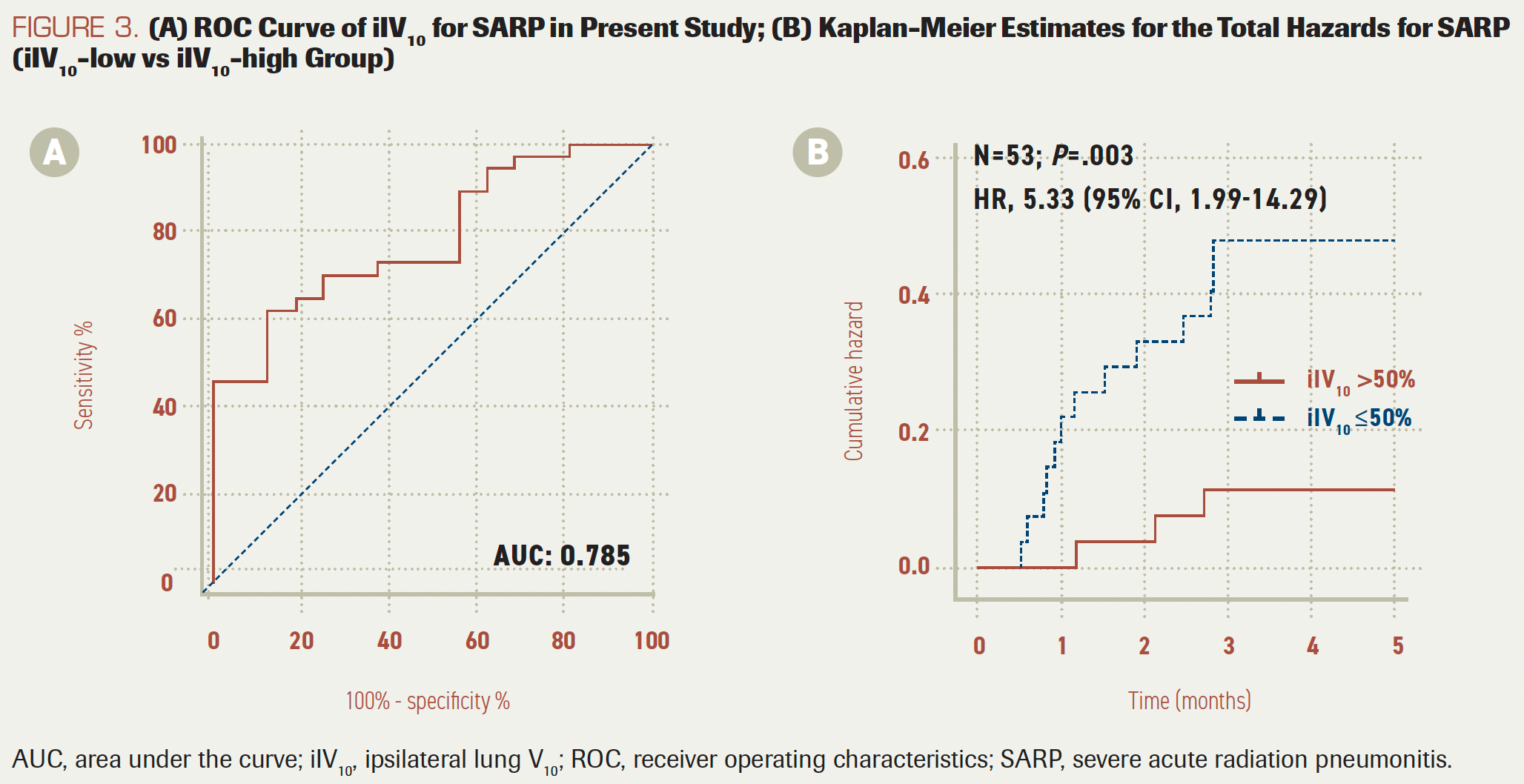
Discussion
Several studies6-10 have examined the treatment of NSCLC in patients with impaired pulmonary function, while others23-27 have focused on the risk factors for SARP. This is the first study to assess the clinical value of conventional-fractionated thoracic radiotherapy for advanced-stage NSCLC in patients with severe pulmonary dysfunction and risk factors for SARP. Our findings showed that thoracic radiotherapy may be associated with survival benefits in this particular population and that ilV10 had predictive value for the incidence of SARP in this cohort.
Induction chemotherapy before radiotherapy has been reported to increase response rate in locally advanced, unresectable NSCLC as compared with radiotherapy alone.28 The randomized phase 3 RTOG 9410 trial (NCT01134861) showed the superiority of CCRT vs sequential chemoradiotherapy for stage III NSCLC in terms of survival.29 According to Daniel R. Gomez, MD, and colleagues, local consolidative therapy, such as radiotherapy and surgical resection, may substantially improve progression-free survival (PFS) in patients with metastatic NSCLC who have not progressed after initial systemic therapy vs maintenance therapy or observations.30 Numerous studies have found that radiotherapy is beneficial for both locally advanced and metastatic lung cancers; radiotherapy has not been widely used to treat patients with severe pulmonary dysfunction because of the toxicity of radiotherapy.
According to Gerben R. Borst, MD, and colleagues, patients with NSCLC had a small decrease in pulmonary function after radiotherapy whereas patients with COPD had a great reduction in pulmonary function.31 Radiotherapy can cause changes in the structure of the lungs, leading to a decrease in pulmonary function, worsening symptoms, and lower quality of life. A multicenter prospective longitudinal study of patients receiving CCRT for advanced NSCLC found substantial decreases in FEV1, total lung capacity, and FVC.32 Despite the fact that radiotherapy has a range of toxic effects,33,34 our research found that radiotherapy may be an independent prognostic factor for OS in patients with NSCLC and severe pulmonary dysfunction. Therefore, when selecting treatment for this population, radiotherapy should be considered.
Numerous investigators have examined the predictors for the incidence of RP. Research groups led by Yuichi Ozawa, MD, PhD,35 and Yun Hee Lee, MD,36 suggested an association between RP and interstitial lung disease. According to Mitsuru Okubo, MD, PhD, and colleagues, subclinical interstitial lung disease was also a significant risk factor for grade 2 or greater RP.37 Tiziana Rancati, MS, found that the presence of COPD is associated with an increased risk of RP.38 Given that patients with impaired pulmonary function are at a higher risk of developing RP, we should pay special attention to the development of RP in these patients following radiotherapy. Our findings showed that ilV10 is an independent predictor of SARP incidence. In a prior study, V10 was found to be statistically significant in relation to RP.39 However, patients in that study received volumetric modulated arc therapy while patients in our study received IMRT; the predictive value of V10 was consistent with our findings. Multivariate analysis revealed a strong correlation between ilV10 and RP in helical tomotherapy–based lung cancer treatment.40 A study of concurrent erlotinib and thoracic radiotherapy to treat NSCLC indicated that V5, V10, V15, V20, and V30 were significantly associated with RP.41 These findings suggested that V10 may play an important role in the development of RP.
SARP was recorded in 25.4% of patients in our previous study13 and in 30.2% of patients in this study. Poorer baseline lung function may account for the higher incidence of SARP in this study. Additionally, our previous study found that DLCO% and MLD were associated with SARP in CCRT for patients with NSCLC affected by pretreatment moderate pulmonary dysfunction, whereas the present study showed a significant correlation between ilV10 and SARP. This disparity may be the result of inconsistencies between the 2 studies. First, the previous study was based on patients with NSCLC and moderate pulmonary dysfunction, while in this study, the subjects were patients with NSCLC and severe pulmonary dysfunction. A decrease in pulmonary function would increase the probability of SARP. Second, the previous study focused on stage III disease, whereas the current study included patients with disease classified as either stage III or IV. The late stage of lung cancer may have an impact on the occurrence of SARP. Third, in this study, only a small proportion of patients received concomitant chemoradiotherapy (due to their poorer performance status) and the rest received sequential chemoradiotherapy or radiotherapy alone, but all patients in the previous study received CCRT, which was proposed as an RP risk factor.24 From our perspective, the patient characteristics in these 2 studies were quite different and thus both studies have distinct clinical significance.
The phase 3 PACIFIC study (NCT02125461) showed that consolidation therapy with durvalumab can significantly improve PFS and OS after definitive chemoradiotherapy for locally advanced unresectable NSCLC.42 Perhaps immunotherapy administered following radiotherapy can increase OS in individuals with severe pulmonary impairment. However, because some of these individuals have preexisting lung disease, it is important to monitor them for the possible development of pneumonitis.
Several limitations to the current research should be noted. First, as it was a retrospective study, there was some selective and biased information. For example, a patient’s large tumor volume could have influenced baseline pulmonary function. As the tumor shrinks with treatment, the pulmonary function may improve, resulting in prolonged survival and a reduced risk of SARP. In univariate analysis, tumor stage was an independent predictor of SARP, and patients with stage III vs stage IV disease were more likely to develop SARP (HR, 5.33; 95% CI, 1.06-26.90; P = .043). One possible reason was that more patients with stage III vs stage IV disease continued to be treated and followed up in our hospital after the completion of radiotherapy. There could be more patients with stage IV disease and SARP who were not treated, but we were unable to collect appropriate clinical data. Second, a relatively small sample was used; larger samples would be necessary to prove our conclusion. However, the strategies of treatment used in this study followed the recommendations of the NCCN guidelines and the conclusions can be useful for oncologists in the course of making clinical treatment decisions and evaluating radiotherapy plans. Third, only ilV10 was linked to the development of SARP in this study, and the best radiotherapy regimen for unresectable NSCLC with severe pulmonary dysfunction has yet to be determined. Future research is required to assess the target population’s radiotherapy-related toxicity risks in order to improve the radiotherapy protocol with the greatest clinical benefit and the least radiation toxicity.
In conclusion, thoracic radiotherapy might be associated with survival benefits among patients with inoperable NSCLC and baseline severe pulmonary dysfunction. Multivariate analysis specified that ilV10 (>50.7%) was an independent predictor for SARP in the present cohort. While future studies are needed to verify our results, these results have value to oncologists as they make clinical treatment decisions and predict the prevalence of SARP among patients with inoperable NSCLC and baseline severe pulmonary dysfunction.
FUNDING: This research did not receive any specific grant from funding agencies in the public, commercial, or not-for-profit sectors.
CONFLICT OF INTEREST: There are no conflicts of interest declared by any of the contributors.
ETHICAL APPROVAL: The study was approved by the West China Hospital Research Ethics Board, Sichuan Province, China.
STATEMENT OF HUMAN AND ANIMAL RIGHTS: This article does not contain any studies with human or animal subjects.
STATEMENT OF INFORMED CONSENT: There are no human subjects in this article and informed consent is not applicable.
AUTHOR AFFILIATIONS:
Qianyue Deng, MD1; Yingjie Zhang, MS2; Yanying Li, MD1; Ting Mei, MD1; Xuexi Yang, MD1; Xiaoman Tian, MD3,4; Xianyan Chen, MD1; Youling Gong, MD, PhD1*
1Department of Thoracic Oncology and State Key Laboratory of Biotherapy, Cancer Center, West China Hospital, Sichuan University, 610041 Chengdu, China
2Center of Radiation Physics, West China Hospital, Sichuan University, 610041 Chengdu, China
3Department of Oncology, Chengdu Jinniu District People’s Hospital, 610031 Chengdu, China
4Department of Oncology, Sichuan Provincial People’s Hospital, 610072 Chengdu, China
*Email address of corresponding author: gongyouling@hotmail.com (Y. Gong).
REFERENCES
- Carr LL, Jacobson S, Lynch DA, et al. Features of COPD as predictors of lung cancer. Chest. 2018;153(6):1326-1335. doi:10.1016/j.chest.2018.01.049
- de Torres JP, Bastarrika G, Wisnivesky JP, et al. Assessing the relationship between lung cancer risk and emphysema detected on low-dose CT of the chest. Chest. 2007;132(6):1932-1938. doi:10.1378/chest.07-1490
- Mayne ST, Buenconsejo J, Janerich DT. Previous lung disease and risk of lung cancer among men and women nonsmokers. Am J Epidemiol. 1999;149(1):13-20. doi:10.1093/oxfordjournals.aje.a009722
- Mouronte-Roibás C, Leiro-Fernández V, Fernández-Villar A, Botana-Rial M, Ramos-Hernández C, Ruano-Ravina A. COPD, emphysema and the onset of lung cancer. a systematic review. Cancer Lett. 2016;382(2):240-244. doi:10.1016/j.canlet.2016.09.002
- Labaki WW, Rosenberg SR. Chronic obstructive pulmonary disease. Ann Intern Med. 2020;173(3):ITC17-ITC32. doi:10.7326/AITC202008040
- Brożek B, Damps-Konstańska I, Pierzchała W, et al. End-of-life care for patients with advanced lung cancer and chronic obstructive pulmonary disease: survey among Polish pulmonologists. Pol Arch Intern Med. 2019;129(4):242-252. doi:10.20452/pamw.4478
- Girard N, Marchand-Adam S, Naccache J-M, et al; Groupe d’Etudes et de Recherche sur les Maladies “Orphelines” Pulmonaires (GERM“O”P). Lung cancer in combined pulmonary fibrosis and emphysema: a series of 47 Western patients. J Thorac Oncol. 2014;9(8):1162-1170. doi:10.1097/JTO.0000000000000209.
- Omote N, Hashimoto N, Morise M, et al. Impact of mild to moderate COPD on feasibility and prognosis in non-small cell lung cancer patients who received chemotherapy. Int J Chron Obstruct Pulmon Dis. 2017;12:3541-3547. doi:10.2147/COPD.S149456
- Palma D, Lagerwaard F, Rodrigues G, Haasbeek C, Senan S. Curative treatment of stage I non-small-cell lung cancer in patients with severe COPD: stereotactic radiotherapy outcomes and systematic review. Int J Radiat Oncol Biol Phys. 2012;82(3):1149-1156. doi:10.1016/j.ijrobp.2011.03.005
- Raviv S, Hawkins KA, DeCamp MM Jr, Kalhan R. Lung cancer in chronic obstructive pulmonary disease: enhancing surgical options and outcomes. Am J Respir Crit Care Med. 2011;183(9):1138-1146. doi:10.1164/rccm.201008-1274CI
- NCCN. Clinical Practice Guidelines in Oncology. Non-small cell lung cancer, version 5.2022. Accessed October 27, 2022. Available at: https://bit.ly/3gYxno4.
- NCCN. Clinical Practice Guidelines in Oncology. Small cell lung cancer, version 1.2023. Accessed October 27, 2022. Available at: https://bit.ly/2JTv4zC.
- Zhou Y, Yan T, Zhou X, et al. Acute severe radiation pneumonitis among non-small cell lung cancer (NSCLC) patients with moderate pulmonary dysfunction receiving definitive concurrent chemoradiotherapy: Impact of pre-treatment pulmonary function parameters. Strahlenther Onkol. 2020;196:505-514. doi: 10.1007/s00066-019-01552-4
- Culver BH, Graham BL, Coates AL, et al; ATS Committee on Proficiency Standards for Pulmonary Function Laboratories. Recommendations for a standardized pulmonary function report. an official American Thoracic Society technical statement. Am J Respir Crit Care Med. 2017;196(11):1463-1472. doi:10.1164/rccm.201710-1981ST
- Miller MR, Hankinson J, Brusasco V, et al; ATS/ERS Task Force. Standardisation of spirometry. Eur Respir J. 2005;26(2):319-338. doi:10.1183/09031936.05.00034805
- Detterbeck FC, Boffa DJ, Kim AW, Tanoue LT. The Eighth Edition Lung Cancer Stage Classification. Chest. 2017;151(1):193-203. doi:10.1016/j.chest.2016.10.010
- Seppenwoolde Y, De Jaeger K, Boersma LJ, Belderbos JSA, Lebesque JV. Regional differences in lung radiosensitivity after radiotherapy for non-small-cell lung cancer. Int J Radiat Oncol Biol Phys. 2004;60(3):748-758. doi:10.1016/j.ijrobp.2004.04.037
- Hope AJ, Lindsay PE, El Naqa I, et al. Modeling radiation pneumonitis risk with clinical, dosimetric, and spatial parameters. Int J Radiat Oncol Biol Phys. 2006;65(1):112-124. doi:10.1016/j.ijrobp.2005.11.046
- International Commission on Radiation Units and Measurements (ICRU) reports 62 and 83. Accessed October 22, 2022. Available at: https://www.icru.org/reports.
- Hodapp N. [The ICRU Report 83: prescribing, recording and reporting photon-beam intensity-modulated radiation therapy (IMRT)]. Strahlenther Onkol. 2012;188(1):97-99. German. doi:10.1007/s00066-011-0015-x
- Stroom JC, Heijmen BJM. Geometrical uncertainties, radiotherapy planning margins, and the ICRU-62 report. Radiother Oncol. 2002;64(1):75-83. doi:10.1016/s0167-8140(02)00140-8
- Common Terminology Criteria for Adverse Events (CTCAE) version 5.0. National Cancer Institute / Cancer Therapy Evaluation Program; 2017. Available at:https://bit.ly/2M6CizL. Accessed April 22, 2021.
- Kharofa J, Gore E. Symptomatic radiation pneumonitis in elderly patients receiving thoracic irradiation. Clin Lung Cancer. 2013;14(3):283-287. doi:10.1016/j.cllc.2012.10.005
- Kim M, Lee J, Ha B, Lee R, Lee KJ, Suh HS. Factors predicting radiation pneumonitis in locally advanced non-small cell lung cancer. Radiat Oncol J. 2011;29(3):181-190. doi:10.3857/roj.2011.29.3.181
- Palma DA, Senan S, Tsujino K, et al. Predicting radiation pneumonitis after chemoradiation therapy for lung cancer: an international individual patient data meta-analysis. Int J Radiat Oncol Biol Phys. 2013;85(2):444-450. doi:10.1016/j.ijrobp.2012.04.043
- Uchida Y, Tsugawa T, Tanaka-Mizuno S, et al. Prediction of radiation pneumonitis using dose-volume histogram parameters with high attenuation in two types of cancer: a retrospective study. PLoS One. 2020;15(12):e0244143. doi:10.1371/journal.pone.0244143
- Zhang X-J, Sun J-G, Sun J, et al. Prediction of radiation pneumonitis in lung cancer patients: a systematic review. J Cancer Res Clin Oncol. 2012;138(12):2103-2116. doi:10.1007/s00432-012-1284-1
- Crinò L, Latini P, Meacci M, et al. Induction chemotherapy plus high-dose radiotherapy versus radiotherapy alone in locally advanced unresectable non-small-cell lung cancer. Ann Oncol. 1993;4(10):847-851. doi:10.1093/oxfordjournals.annonc.a058391
- Curran WJ Jr, Paulus R, Langer CJ, et al. Sequential vs. concurrent chemoradiation for stage III non-small cell lung cancer: randomized phase III trial RTOG 9410. J Natl Cancer Inst. 2011;103(19):1452-1460. doi:10.1093/jnci/djr325
- Gomez DR, Blumenschein GR Jr, Lee JJ, et al. Local consolidative therapy versus maintenance therapy or observation for patients with oligometastatic non-small-cell lung cancer without progression after first-line systemic therapy: a multicentre, randomised, controlled, phase 2 study. Lancet Oncol. 2016;17(12):1672-1682. doi:10.1016/S1470-2045(16)30532-0
- Borst GR, De Jaeger K, Belderbos JS, Burgers SA, Lebesque JV. Pulmonary function changes after radiotherapy in non-small-cell lung cancer patients with long-term disease-free survival. Int J Radiat Oncol Biol Phys. 2005;62(3):639-644. doi:10.1016/j.ijrobp.2004.11.029
- Torre-Bouscoulet L, Arroyo-Hernández M, Martínez-Briseño D, et al. Longitudinal evaluation of lung function in patients with advanced non-small cell lung cancer treated with concurrent chemoradiation therapy. Int J Radiat Oncol Biol Phys. 2018;101(4):910-918. doi:10.1016/j.ijrobp.2018.04.014
- Banfill K, Giuliani M, Aznar M, et al; IASLC Advanced Radiation Technology Committee. Cardiac toxicity of thoracic radiotherapy: existing evidence and future directions. J Thorac Oncol. 2021;16(2):216-227. doi:10.1016/j.jtho.2020.11.002
- Bradley JD, Hu C, Komaki RR, et al. Long-term results of NRG oncology RTOG 0617: standard- versus high-dose chemoradiotherapy with or without cetuximab for unresectable stage III non-small-cell lung cancer. J Clin Oncol. 2020;38(7):706-714. doi:10.1200/JCO.19.01162
- Ozawa Y, Abe T, Omae M, et al. Impact of preexisting interstitial lung disease on acute, extensive radiation pneumonitis: retrospective analysis of patients with lung cancer. PLoS One. 2015;10(10):e0140437. doi:10.1371/journal.pone.0140437
- Lee YH, Kim YS, Lee SN, et al. Interstitial lung change in pre-radiation therapy computed tomography is a risk factor for severe radiation pneumonitis. Cancer Res Treat. 2015;47(4):676-686. doi:10.4143/crt.2014.180
- Okubo M, Itonaga T, Saito T, et al. Predicting risk factors for radiation pneumonitis after stereotactic body radiation therapy for primary or metastatic lung tumours. Br J Radiol. 2017;90(1073):20160508. doi:10.1259/bjr.20160508
- Rancati T, Ceresoli GL, Gagliardi G, Schipani S, Cattaneo GM. Factors predicting radiation pneumonitis in lung cancer patients: a retrospective study. Radiother Oncol. 2003;67(3):275-283. doi:10.1016/s0167-8140(03)00119-1
- Wu K, Xu X, Li X, et al. Radiation pneumonitis in lung cancer treated with volumetric modulated arc therapy. J Thorac Dis. 2018;10(12):6531-6539. doi:10.21037/jtd.2018.11.132
- Kim Y, Hong SE, Kong M, Choi J. Predictive factors for radiation pneumonitis in lung cancer treated with helical tomotherapy. Cancer Res Treat. 2013;45(4):295-302. doi:10.4143/crt.2013.45.4.295
- Zhuang H, Hou H, Yuan Z, et al. Preliminary analysis of the risk factors for radiation pneumonitis in patients with non-small-cell lung cancer treated with concurrent erlotinib and thoracic radiotherapy. Onco Targets Ther. 2014;7:807-813. doi:10.2147/OTT.S62707
- Antonia SJ, Villegas A, Daniel D, et al; PACIFIC Investigators. Durvalumab after chemoradiotherapy in stage III non-small-cell lung cancer. N Engl J Med. 2017;377(20):1919-1929. doi:10.1056/NEJMoa1709937
